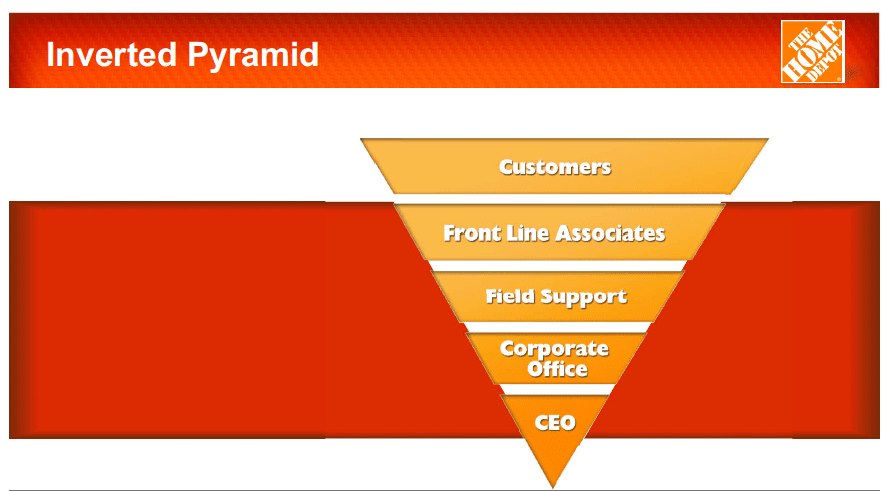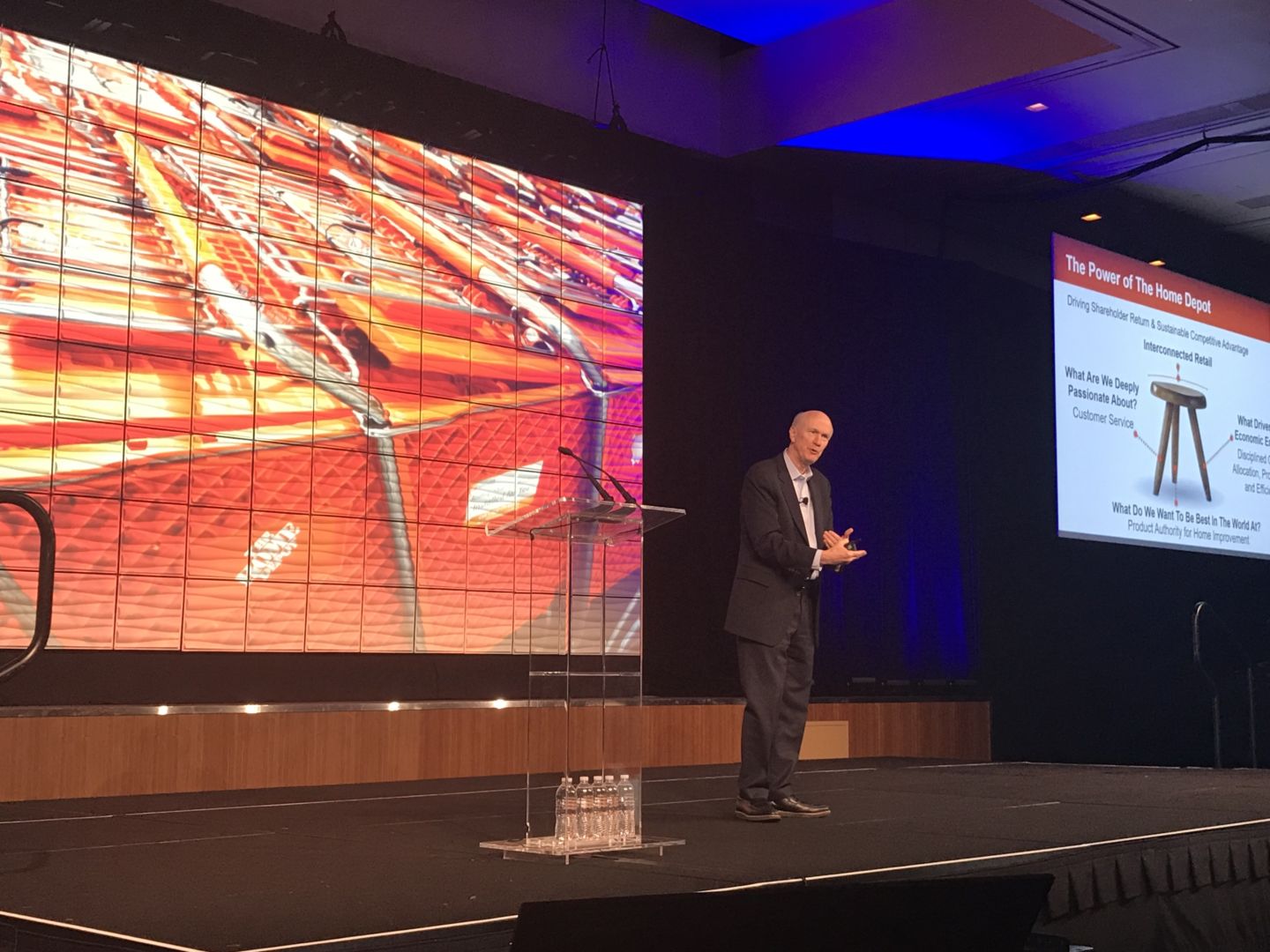When Frank Blake became chairman and CEO of The Home Depot in 2007 — after then-CEO Robert Nardelli stepped down amid criticism of his pay package and management style — the first thing he did was focus on the core of the company. The retailer operated a variety of different store banners and formats, including Expo Design Center, YardBIRDS and HD Bath, and Blake cut them all. He also took a half-billion-dollar write-off to stop building new stores. “For the last 11 years, The Home Depot built very few stores as we grew sales by approximately $40 million,” he said during a keynote at the Aptos Engage conference, held April 16-19 in Las Vegas.
Blake shared valuable leadership and business lessons learned during his time at The Home Depot. “[These lessons] were learned very rapidly because I didn’t have the time to sit and study,” said Blake. “I had the benefit of having worked for some extraordinary leaders in the past. I worked for Jack Welch (former chairman and CEO of GE). Earlier in my career, I worked for George H. W. Bush, I worked for George Bush the son as Deputy Secretary of Energy and I worked for Ronald Reagan. So I’ve seen a lot of leaders and a lot of context. I had some notions but this was really beyond my learning of what it meant to run an organization like The Home Depot.”
To get started, Blake turned to Jim Collins’ book, Good to Great, which says that every business needs to answer three questions:
- What are we deeply passionate about? — “In The Home Depot’s case, that was customer service,” said Blake.
- What do we want to be best in the world at? — “In our case, that was product authority for home improvement.”
- What drives our economic engine? — “Which was interestingly not a question people spent a lot of time thinking about,” he said. “That changed dramatically for us when we stopped building and spending $2 million on new stores. When we stopped, we deployed it to things like IT and the like, and it gave us a completely different view of what drove our economic engine.”
The CEO Is At The Top? Think Again

Another important tool for Blake was an Inverted Pyramid diagram, from the book titled Built From Scratch. The diagram puts customers at the top, followed by front-line associates, then field support, the corporate office and the CEO at the very tip on the bottom. “I believe this is foundationally important for any company, particularly retail,” he said.
Blake set the stage for why he came to the Inverted Pyramid as a business model: “Imagine you’re in my shoes and you haven’t really been on the retail side of the business; you haven’t run an organization in any way,” he said. “You’re appointed by the board to be the CEO and basically the next day you have to address 325,000 people.”
To add to the pressure, Blake had to address those 325,000 people not with a corporate memo but via TV; sets are placed in all The Home Depot break rooms to deliver companywide news. Blake had to explain to the associates not just what the new person wanted to do, but who the new person was. “They had never heard of Frank Blake,” he noted. Blake turned to his son, who just happened to work as a Manager for The Home Depot at the time, and asked him what he should talk about.
His son told him that he started his store meetings off by reading from Built From Scratch. So that’s what Blake did, and that’s how he found the Inverted Pyramid.
“I spent my time thinking about what does [the Inverted Pyramid] actually mean,” said Blake. “It’s a much truer representation of how businesses actually work than pyramids the other way around. In my experience, where leaders very often go wrong is when they think their pronouncements actually flow down to the rest of the organization with the benefit of gravity. But no one actually cares what you have to say. They’re trying to do their job as best as they can. As leader, you have to get your message, your direction up through the organization.”
What It Means To Be In A Leadership Position
Blake continued to highlight additional principles embodied in the Inverted Pyramid, including:
- Understand that when you’re in a leadership position, nothing flows downhill. It is all uphill and it is all hard work;
- Understand that the weight of the organization is on you, which is why your integrity has to be the first order.
- Understand that if you’re communicating with your front-line associates, the communication can’t just be yours. It has to be simple and important; and
- Understand that everything important in your organization is above you and you have to listen.
Regarding the last bullet, Blake added, “For everyone that leads an organization, you come in and ask, ‘How’s it going?’ There is only one right answer to that question: ‘Everything is great.’ Understand that that’s how all of your employees reply to ‘How’s it going?’ So, if you want to listen and understand the important things happening above your head, you have to figure out a much more engaged way of having dialogue with them.”
Rather than asking how things are going, “I would take whatever project we were working on and ask ‘Why is X not going well?’” Blake added. “Now, I had no idea why it wasn’t going well or not going well, but usually X wasn’t. That was true permission for people to tell you what they think, and you have to have that. You have to aggressively listen.”
Celebrate Your Employees
Blake’s time at The Home Depot revolved around his employees, and it was important for him to celebrate and recognize them frequently. He said he would send hand-written notes to associates thanking them for their work, as well as create videos for the break room featuring the employees’ children stating how proud they are of their parents who work at The Home Depot.
“One of my dominant learnings is the power of recognition,” said Blake. “We all know as business people, there is a great phrase: ‘We get what we measure.’ That’s absolutely true, and I would give a corollary to that: You get what you celebrate. As a leader, you establish what you think is significant by what you recognize and what you thank. It’s straightforward but shocking how few businesses have little intention and consistency to how they recognize and celebrate their associates.
“Organizations make up stories of their own,” Blake added. “Leaders’ names are thrown around all the time. Your organization is telling stories about what you want. Tell your own damn stories and take the time to tell that story. And make sure you communicate, recognize and celebrate the people who are reflecting that story, that reflects where you want the organization to go.”













